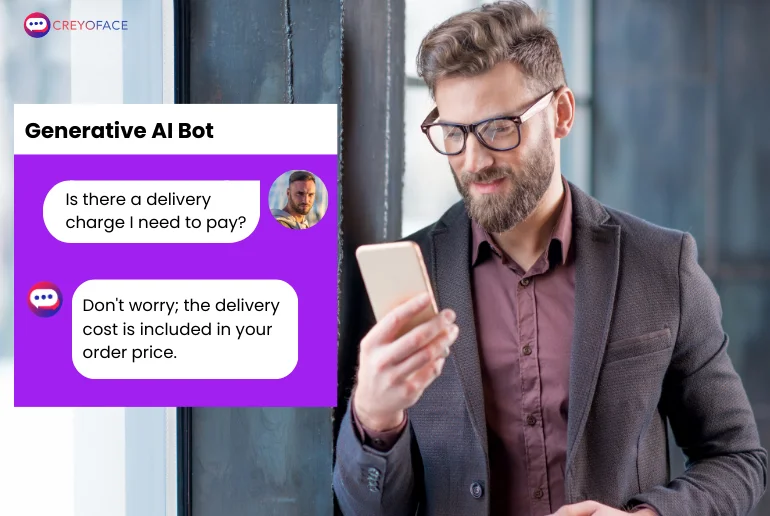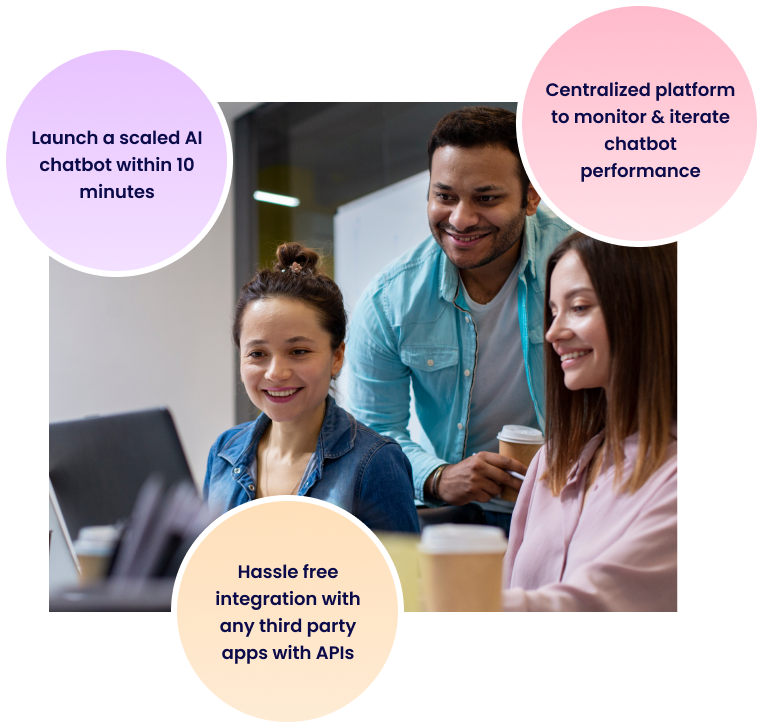Are you looking to give your business a boost? Generative AI chatbots is what you need. With generative AI, your business can do more and keep customers happier. It’s an essential tool for any company wanting to succeed today.
Introduction
Generative AI chatbots are like a super-smart computer that can create new things, such as stories, pictures, or even new inventions. This big leap in AI technology makes automating creative tasks much faster than many thought possible. It’s opening up exciting possibilities for businesses to offer new services or develop new ways to make money.
This technology is getting a lot of buzz everywhere, from the news to conversations in the community, making many people curious and excited about what it can do.
Companies, researchers, and regular folks are all trying out Generative AI to see its capabilities. With so much interest, it’s essential to dive deep and understand how this technology works and what it might mean for the future of businesses and everyday life.
Current State of Generative AI Chatbots in Enterprises
Chatbots have become increasingly integral in enterprise settings, offering a range of functionalities that streamline operations, enhance customer service, and automate repetitive tasks. Their applications vary widely across industries, from banking and finance to healthcare and retail, demonstrating their versatility and efficiency.
Here’s an overview of how chatbots are currently used in enterprise settings.
- Customer Service: Chatbots offer 24/7 support, handling inquiries and issues to reduce human agent workload and improve response times.
- Sales and Marketing: They guide potential customers, offer personalized recommendations, and provide instant quotes to enhance the buying experience.
- HR and Recruitment: Chatbots streamline recruitment by screening candidates, scheduling interviews, and answering FAQs.
- Internal Operations: Used to manage employee requests, automate tasks, provide information, and streamline operations.
- Personalized Experiences: AI and machine learning enable chatbots to offer customized interactions, improving user engagement and satisfaction.
- Training and Education: They provide interactive tools for personalized learning experiences and immediate feedback.
Limitations of Traditional Chatbot
Even though traditional chatbots offer substantial benefits in various enterprise applications, they come with notable limitations that can impact their effectiveness and user experience. Let’s look at some limitations that traditional chatbots have.
- Limited Responses rely on scripted answers, leading to generic or irrelevant replies to complex or unique user queries.
- Lack of Personalization: Chatbots cannot offer personalized interactions without advanced algorithms, diminishing user engagement.
- Difficulty Understanding Natural Language: Struggles with natural language understanding result in misunderstandings or incorrect responses.
- Integration Challenges: Difficulties integrating with existing systems can restrict access to real-time data and relevant responses.
- Scalability Issues: Traditional chatbots may not meet growing demands, affecting performance and response times.
- Limited Emotional Intelligence: The absence of emotional intelligence restricts the ability to provide empathetic customer service.
What is Generative AI, and How Does it Transform Chatbots?
In the context of chatbots, generative AI refers to the application of artificial intelligence technologies that enable chatbots to autonomously generate natural language responses to user inputs rather than selecting from a pre-defined set of responses. It is achieved through advanced deep learning models, such as Generative Pre-trained Transformers (GPT), a subset of machine learning models designed explicitly for generating text.
Generative AI chatbots use:
Natural Language Processing (NLP) breaks down and understands human language, helping them grasp what people are asking and the details of the conversation.
Machine Learning (ML) and Deep Learning (DL), where they learn from vast amounts of text to recognize language patterns and how to form sentences.
Generative pre-trained transformer models (like GPT-3 and GPT 4) are advanced tools already trained on many online texts. They can create text that makes sense based on what you say to them, making chatbots more competent at handling different topics.
Differences between Generative AI-powered Chatbots and Rule-based Chatbots
When discussing what generative AI chatbots can do, it’s essential to see how they differ from rule-based AI bots.
Let’s check out these differences.
Response Generation
Generative AI Chatbots: Create new, contextually relevant responses dynamically, allowing for varied and nuanced conversations.
Rule-Based Chatbots: Rely on a fixed set of predefined responses, limiting conversations to anticipated scenarios.
Learning and Adaptation
Generative AI Chatbots: Continuously learn from interactions, improving their responses over time based on new data.
Rule-Based Chatbots: Do not learn or adapt; updates and improvements require manual intervention.
Conversational Flexibility
Generative AI Chatbots: Can handle a wide range of topics and adjust to unexpected user inputs by generating appropriate responses.
Rule-Based Chatbots: Operate within a constrained scope, struggling with queries outside their programmed rules.
Natural Language Understanding
Generative AI Chatbots: Possess an advanced understanding of language nuances, context, and user intent, thanks to NLP and machine learning.
Rule-Based Chatbots: Have a limited understanding of natural language and rely on specific keywords or phrases to trigger responses.
Personalization
Generative AI Chatbots: Capable of tailoring conversations to individual users by leveraging data from past interactions.
Rule-Based Chatbots: Offer limited personalization through predefined branching scenarios based on user choices.
Benefits of Integrating Generative AI into Chatbots
Integrating generative AI into chatbots offers multiple benefits:
Enhanced User Experience: Generative AI enables chatbots to engage in more natural and fluid conversations, closely mimicking human interactions, which enhances the overall user experience.
Scalability and Efficiency: AI-powered chatbots can simultaneously manage thousands of queries, significantly reducing user wait times and reducing business operational costs.
Personalization: Generative AI chatbots can tailor conversations to individual preferences by analyzing user data and previous interactions, leading to higher customer satisfaction.
Continuous Learning and Improvement: These chatbots continuously learn from each interaction, allowing them to refine their responses and become more accurate and helpful over time.
Real-world Applications and Success Stories
Integrating generative AI into chatbots offers numerous benefits for businesses, fundamentally transforming how they interact with customers, streamlining operations, and enhancing the overall customer experience. Here are some real-world examples and success stories.
EVA by HDFC Bank
HDFC Bank, one of India’s leading private sector banks, has successfully integrated generative AI into their customer service operations by deploying a chatbot named EVA (Electronic Virtual Assistant). Since integrating EVA, HDFC Bank has reported significant improvements in business metrics.
- Generates 50,000+ qualified leads monthly, boosting revenue.
- EVA processes 16 million+ questions monthly, reducing support costs.
- Over 95.5% accuracy enhances customer satisfaction.
- Replaces 800+ human agents, saving on training and overheads.
Max Life Insurance
Max Life Insurance integrates generative AI into their email chatbots. This bot can answer emails on its own, sort out the emails by what they’re about, and ensure they get to the right people in the company to handle them. As a result, they could achieve the following.
- Handled over 200,000 emails with more than 90% accuracy.
- Achieved approximately 98% automation in email support.
- Instantly categorizes and assigns emails automatically.
- Works with several CRMs and databases for streamlined operations.
SBI Card
SBI Cards created ILA, a generative AI-driven assistant to respond to customer inquiries and guide users toward the best products for their needs.
- ILA served as primary customer support, addressing over 23 million queries.
- Over 25,000 service requests were booked via ILA.
- The AI solution garnered 130,000+ leads, significantly boosting revenue.
Overcoming Challenges and Concerns
Although Generative AI promises remarkable advancements, it’s not without its challenges. Let’s explore some of these challenges and consider potential solutions.
Privacy Issues
Generative AI chatbots often require access to user data to personalize responses and improve performance. However, collecting and processing this data raises privacy concerns, especially regarding sensitive information.
To protect user privacy with AI chatbots, businesses should have firm rules, like following GDPR or CCPA and asking for permission before collecting data. They should also hide or change user data when possible and limit access. Regular checks help find and fix any privacy issues fast.
Handling Misinformation and Fake News
Generative AI chatbots have the potential to propagate misinformation or fake news if not adequately monitored. To address this concern, businesses should implement fact-checking mechanisms to verify the accuracy of information provided by the chatbot.
Additionally, educating users about the limitations of AI technology and encouraging critical thinking can help mitigate the spread of misinformation.
Potential for Generating Inappropriate Responses
Generative AI chatbots may generate inappropriate content due to biases or misinterpretations. To prevent this, continuous monitoring and strict guidelines are crucial. Filters can help set boundaries for AI responses, while regular training and updates can reduce biases and improve accuracy.
How to Get Started with Generative AI Chatbots
Integrating generative AI into existing chatbot strategies can enhance user interactions and improve overall performance. Here’s how to get started:
Assess Current Capabilities
Evaluate the current state of your chatbot system, including its functionalities, limitations, and performance metrics.
Define Objectives
Determine specific goals and objectives for integrating generative AI, such as enhancing conversational abilities, improving user engagement, or providing more personalized responses.
Choose AI Technology
Research and select the appropriate generative AI technology based on scalability, compatibility with existing systems, and capabilities to meet your defined objectives.
Select Partners
Identifyy providers or partners with expertise in generative AI development and deployment. Consider their track record, reputation, and ability to support your project requirements.
Develop Implementation Plan
Outline a clear implementation plan that includes use cases, desired outcomes, and timelines for integrating generative AI capabilities into your existing chatbot platform.
Design Conversational Flows
Design conversational flows and scripts to seamlessly incorporate generative AI responses into your chatbot’s user interactions.
Test and Optimize
Conduct thorough testing of the integrated chatbot to ensure functionality, accuracy, and user experience. Optimize the chatbot based on testing feedback and performance analysis.
Monitor and Refine
Continuously monitor the chatbot’s performance and user interactions. Collect user feedback and analyze conversation logs to identify areas for improvement and refine the chatbot’s responses over time.
By following these steps, you can effectively integrate generative AI into your existing chatbot strategies and enhance your chatbot system’s overall performance and user experience.
How to Get Started with Generative AI Chatbots
Integrating generative AI into existing chatbot strategies can enhance user interactions and improve overall performance. Here’s how to get started:
Assess Current Capabilities: Evaluate the current state of your chatbot system, including its functionalities, limitations, and performance metrics.
Define Objectives: Determine specific goals and objectives for integrating generative AI, such as enhancing conversational abilities, improving user engagement, or providing more personalized responses.
Choose AI Technology: Research and select the appropriate generative AI technology based on scalability, compatibility with existing systems, and capabilities to meet your defined objectives.
Select Partners: Identify providers or partners with generative AI development and deployment expertise. Consider their track record, reputation, and ability to support your project requirements.
Develop Implementation Plan: Outline a clear implementation plan that includes use cases, desired outcomes, and timelines for integrating generative AI capabilities into your existing chatbot platform.
Design Conversational Flows: Design conversational flows and scripts to seamlessly incorporate generative AI responses into your chatbot’s user interactions.
Test and Optimize: Conduct thorough testing of the integrated chatbot to ensure functionality, accuracy, and user experience. Optimize the chatbot based on testing feedback and performance analysis.
Monitor and Refine: Continuously monitor the chatbot’s performance and user interactions. Collect user feedback and analyze conversation logs to identify areas for improvement and refine the chatbot’s responses over time.
By following these steps, you can effectively integrate generative AI into your existing chatbot strategies and enhance your chatbot system’s overall performance and user experience.
Conclusion
Generative AI is a big deal for businesses because it helps them better serve their customers, work more efficiently, and develop cool new ideas. It’s great for answering customer questions quickly, sorting out emails, and even making new products that people will love.
Now, let’s quickly go over the key points we talked about:
- Generative chatbots are versatile, improving banking, healthcare, sales, and HR services.
- These chatbots overcome the limitations of traditional bots by offering personalized and adaptive conversations.
- Generative AI chatbots, like HDFC’s EVA and SBI’s ILA, enhance customer interactions with dynamic responses.
- Challenges like privacy concerns and misinformation are managed with strict privacy laws, fact-checking, and continuous monitoring.
Generative AI can change how you connect with customers, making your service more personal and efficient. It’s a wise choice that can make your business run smoother, keep customers closer, and help you earn more.
Let’s use generative AI to take customer service to the next level.
Are you curious about integrating Generative AI into your business strategy, or have you already started the journey?
Feel free to share your experiences or questions with us. Don’t hesitate to reach out if you want more insights or have any doubts.
Sign in to Creyoface and schedule a call with us.
Let’s start a conversation and explore how AI can make a difference in your business together.
Ready To Explore?
Frequently Asked Questions?
What is chatbot integration with CRM?
Integration of chatbots with CRM involves linking AI-driven chat interfaces with customer relationship management software. It enables automated communication and data exchange between the two systems.
How do chatbots improve CRM functionality?
Chatbots enhance CRM by automating customer interactions, capturing and updating data in real-time, and providing instant customer support. It leads to improved efficiency and customer satisfaction.
Are chatbot-CRM integrations secure?
Yes, when properly implemented, these integrations are secure. They use encryption and compliance standards to protect sensitive customer data.








